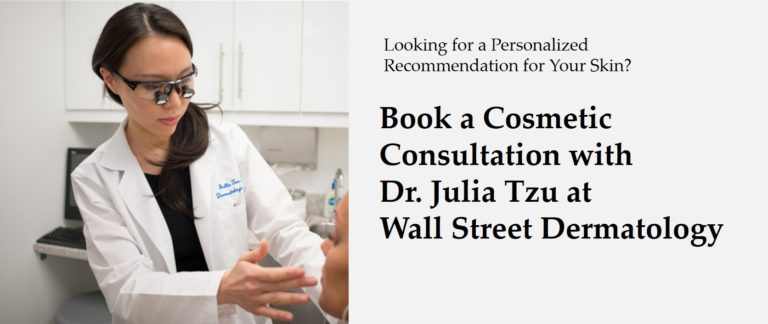Erase the Past:
Scar Revision NYC
Learn What's Involved in Surgically Treating Scars & How to Get the Best Cosmetic Outcomes
- Last Updated: May 13, 2025
- By Julia Tzu, MD FAAD
SCAR REVISION AT WALL STREET DERMATOLOGY
While scars are a natural sign that the body is healing, they can impact your confidence and serve as an unwanted physical reminder of the past. With scar revision in NYC, Wall Street Dermatology uses advanced technology to reduce the appearance of scars and restore smooth, blemish-free skin.
Dr. Julia Tzu, a triple-board certified cosmetic and surgical dermatologist, uses innovative surgical procedures, microneedling, and laser treatment to fade away scars. Whether you’re looking to eliminate discoloration, improve skin texture and contour, or remove excess scar tissue, our surgical and non-surgical scar removal can restore your skin’s natural beauty.
Book an appointment with Wall Street Dermatology today and discover the transformative benefits of scar removal in NYC.
Dermatologist Dr. Julia Tzu’s Perspective on Scar Treatments
“The majority of my work on a daily basis deals with minimizing scarring when performing a surgery or other invasive skin procedure. This has led to a profound experiential understanding and appreciation of scars and how to optimize scarring outcomes. One of my favorite procedures is scar revision/reduction because it invokes the knowledge, surgical skill, and experience that is the very nature of my daily work and passion. I am honored to be part of the journey that allows people to erase and forget their past scars.”- Dr. Julia Tzu, MD, FAAD
Types of Scar Revisions
There are a variety of scar removal procedures we offer in New York City that result in visibly improved cosmetic outcomes. These cosmetic procedures vary based on their approach to treating scars and the types of scars they treat. Scar revisions often require a combination approach that involves multiple treatment modalities. This is applicable to complex scars with unique characteristics that traditional unidimensional methods can’t address.
During your consultation, Dr. Tzu will review your medical history, consider any unique characteristics of your scar type and location, and formulate a customized treatment plan that’s right for you. Below are the three most common types of scar treatments in NYC.
Surgical Scar Revision
Surgical scar revision in NYC is the most traditional and one of the most powerful methods of improving the appearance of scars. When performed with precision, skill, and experience, the outcome can be superior to results obtained from lasers, microneedling, or dermabrasion. Surgical scar revision may not be appropriate for all types of scars, as it is more often used to correct an existing postoperative scar.
Choosing the right surgeon is key to obtaining optimum results. Dermatologic surgeons who have advanced fellowship training in Mohs surgery and skin reconstruction are specialists in surgical scar treatments, as their daily work involves strictly skin surgery.
Dr. Tzu received fellowship training at one of the largest and most prestigious dermatology skin surgery centers in the world, the Hospital of the University of Pennsylvania, and has over a decade of experience in skin surgery and reconstruction.
Laser Scar Treatment
Laser scar treatment is another procedure commonly used for scar revision in NYC. The exact type of laser utilized depends on the type of scar treated. Pulsed dye lasers are often used to minimize red discoloration of early-stage scars, while nonablative and ablative fractional lasers homogenize older, white scars.
Other factors that determine whether lasers should be utilized for scar treatment include skin color, treatment purpose, and the patient’s medical history. Laser scar treatment often takes multiple sessions to produce the desired results and is ideal for patients who prefer a non-invasive approach. However, this treatment may or may not be suitable for all scar types, such as acne scars, keloid scars, depressed scars, and raised scar tissue.
Microneedling
Microneedling is a highly effective, non-invasive cosmetic procedure that helps normalize discoloration and textural differences found in scar tissue. This type of scar treatment in NYC is often preferred by patients who desire a non-invasive approach or who have scars that aren’t severe enough to need surgical scar revision.
Similar to fractional nonablative laser treatment, microneedling is a highly precise and controlled cosmetic procedure. This type of scar revision can treat various skin segments with less concern about blending in with non-treated areas. Various microneedling settings are available for different levels of aggressivity. This scar treatment in NYC typically takes multiple sessions to produce the desired results.
Is Scar Revision Worth It?
There are many benefits to receiving a scar revision in NYC. If you have a scar that hasn’t faded with time and remains prominent, scar revision in NYC is worth it. Depending on your scar, there are different treatment options to achieve the following results:
Reduces Discoloration of Scars
Scar revision in NYC can reduce the discoloration of noticeable scars so they are less visible. Multiple types of treatment can help achieve this look. Microneedling prompts your skin to produce more collagen, which can help visibly blend scar tissue with normal tissue. Laser resurfacing can reduce the discoloration of scars by removing the structural source of the discoloration.
No matter what scar treatment you choose, these cosmetic procedures can make your scars look more blended and aesthetically balanced.
Removes Excess Scar Tissue
Instead of reducing the appearance of scars, Dr. Tzu can remove excess scar tissue entirely. Surgical scar treatment involves physically removing the scar tissue and then reconstructing, or placing the skin back together. This leaves a thin, less noticeable post-surgical scar.
Improve Texture of Scars
Microneedling and lasers can normalize discoloration and help normalize the texture of existing scars and the surrounding skin. Both procedures can increase surface collagen production within scar tissue. Multiple treatments are required for these noninvasive procedures.
Types of Scars We Treat
No matter what kind of scar you have, scar treatment at Wall Street Dermatology in NYC can help. Below are the most common scars Dr. Tzu treats.
- Acne Scars
- Hypertrophic Scars
- Keloid Scars
- Atrophic Scars
- Chickenpox Scars
- Post-Surgery Scars
Scar Revision Cost in NYC
The cost of scar revision depends on the size and location of the scar and the complexity of the cosmetic procedure. In general, average costs for scar treatment vary between $550 to $3,000 per treatment session. You may need multiple sessions.
Scar Revision Aftercare
Depending on the scar revision treatment you choose, the healing process will be different. Following a surgical scar revision, you’ll be able to return home the same day. During the first and second weeks of scar revision recovery, you may experience swelling, bruising, and mild discomfort in the area of the scar.
Dr. Tzu will remove the sutures within 5 to 14 days. After the first two weeks, the swelling and bruising will begin to subside. In the next several months after suture removal, the scar will return to a normal color and fade.
Following a microneedling procedure, your skin will look sunburned for several days. Laser scar treatment involves a 2 week recovery time during which you should avoid sun exposure and friction/trauma to the skin.
Scar Revision Results
A successful treatment may result in a scar that is smoother, less visible, or more aesthetically pleasing. Additionally, in cases where the scar has caused restricted movement, scar revision may restore functionality.
Schedule a Scar Revision Consultation at Wall Street Dermatology
To discuss what type of scar treatment in NYC is best to treat your scar, schedule a consultation with Dr. Tzu. We look forward to exploring how we can restore the natural beauty of your skin.
Scar Revision FAQ
Who is a Good Candidate for Scar Revision Surgery?
Individuals of any age who are in good health are good candidates for scar revision. These procedures are minimally invasive and require little recovery or downtime.
However, individuals with certain conditions or taking certain medications should consult their doctor before undergoing scar revision. Some of these conditions and medications include:
- Diabetes
- Immunosuppressant medications
- Isotretinoin or Accutane for severe acne
- History of keloids or poor wound healing
- History of irradiation on the area to be treated
How many scar revision treatments do I need?
The number of scar revision treatments required depends on the type of cosmetic procedure utilized and the nature of the scar to be treated. Surgical scar revision can be performed in one procedure for simple cases, but may require multiple treatments for more complex cases. Noninvasive procedures such as microneedling and laser will almost always require multiple sessions, often 4-6 sessions.
When can I start scar treatment after surgery?
You can begin scar treatment in NYC after the scar has completely healed. Scar treatments are not appropriate for open or actively healing wounds. While it depends on the type of scar to be treated and treatment type, scar treatment can begin anywhere between 1-3 months after scar tissue is generated. The optimum timing for scar revision will be determined at the time of your consultation with Dr. Tzu.
Can scar revision treat old scars?
Yes, scar revision can treat old scars. Scar treatment in NYC can help reduce the appearance of old scars and smooth the texture of the skin.
Does insurance cover scar treatment?
No, health insurance typically does not cover scar treatments in NYC, as it is considered a cosmetic procedure intended to enhance the appearance of the skin.
At what age can you get scar revision?
You can receive scar treatment at any age. If you are physically healthy and have a scar that you want removed or improved, scar treatment in NYC can be an excellent option for you.


